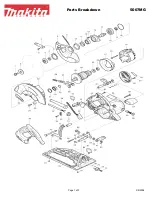
8
English
Switch
Pull the trigger switch to turn the motor ON. Releasing the trigger
turns the motor OFF. This tool has no provision to lock the switch in
the ON position, and should never be locked ON in any way.
Workpiece Support
Figures 9 and 11 show proper sawing position. Figures 10 and 12
show an unsafe condition. Hands should be kept away from cutting
area, and power cord is positioned clear of the cutting area so that it
will not get caught or hung up on the work.
To avoid kickback, DO support board or panel NEAR the cut,
(Figures 9, 11). DON’T support board or panel away from the cut
(Figures 10, 12). When operating the saw, keep the cord away from
the cutting area and prevent it from becoming hung up on the work
piece.
WARNING:
It is important to support the work properly and to hold
the saw firmly to prevent loss of control which could cause personal
injury; Figure 11 illustrates typical hand support of the saw.
ALWAYS DISCONNECT SAW BEFORE MAKING ANY
ADJUST MENTS! Place the work with its “good” side - the one on
which appearance is most important - down. The saw cuts upward, so
any splintering will be on the work face that is up when you saw it.
Cutting
Support the work so that the waste will be on your right. Place the
wider portion of the saw shoe on that part of the work piece which is
solidly supported, not on the section that will fall off when the cut is
made. As examples, Figure 11 illustrates the RIGHT way to cut off
the end of a board, and Figure 12 the WRONG way. Always clamp
work. Don’t try to hold short pieces by hand! Remember to support
cantilevered and overhanging material. Use caution when sawing
material from below.
Be sure saw is up to full speed before blade contacts material to
be cut. Starting saw with blade against material to be cut or pushed
forward into kerf can result in kickback.
FIG. 11
FIG. 10
FIG. 9
FIG. 12
Summary of Contents for DW366
Page 2: ......











































